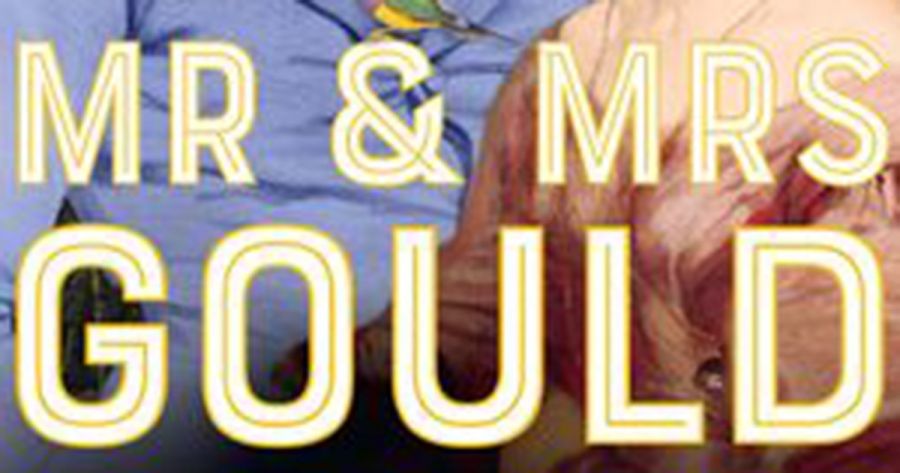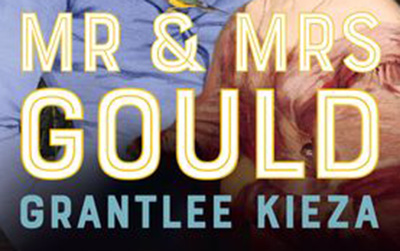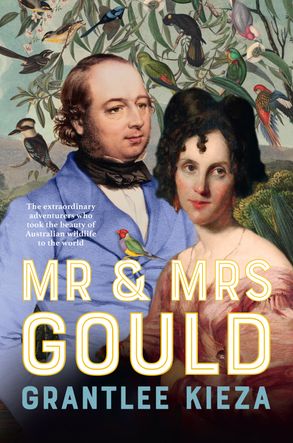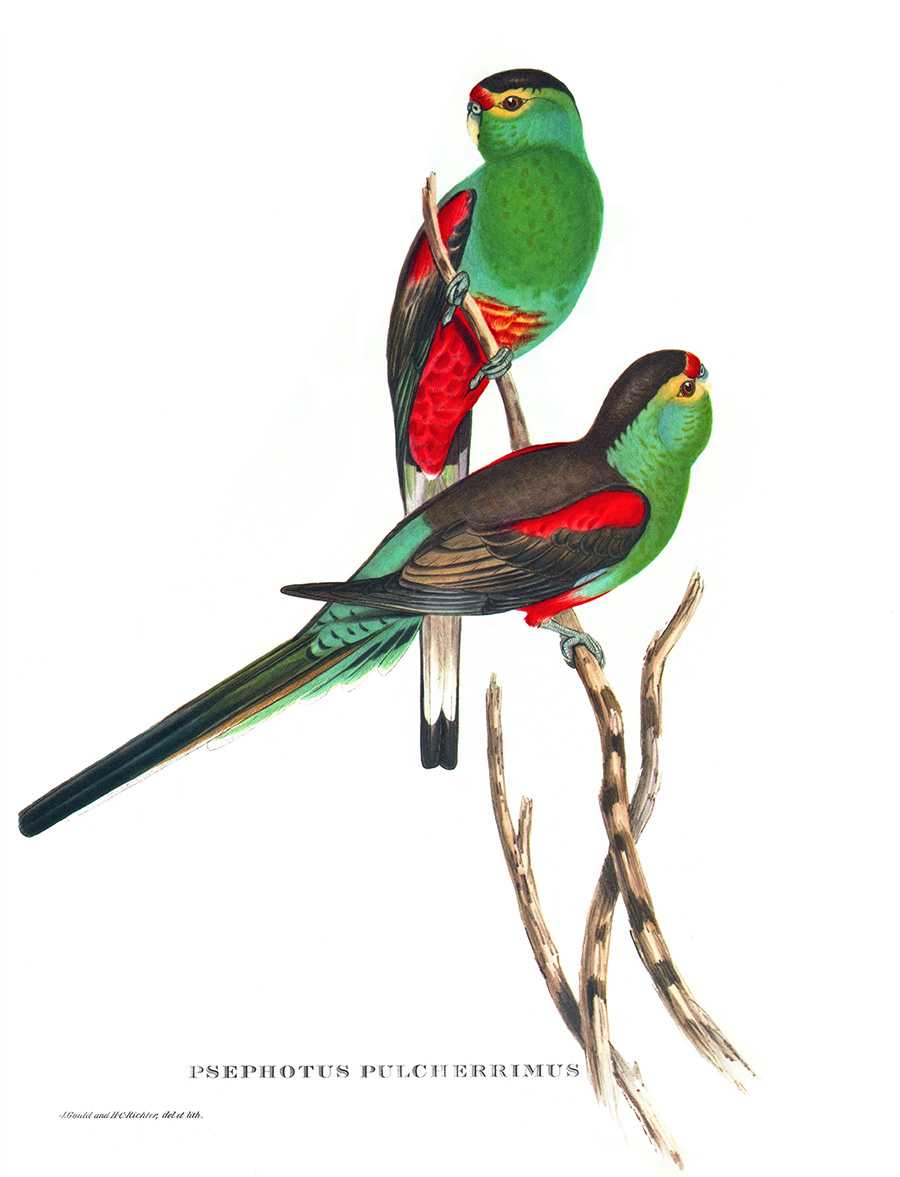
- Free Article: No
- Contents Category: Natural History
- Review Article: Yes
- Article Title: Pulcherrimus, most beautiful
- Article Subtitle: The legacies of John and Elizabeth Gould
- Online Only: No
- Custom Highlight Text:
For much of the nineteenth century, John Gould (1804-81) was known internationally as ‘the bird man’. His fame derived from two main sources: first, as the author and publisher of a series of sumptuous, folio-sized books featuring beautiful, hand-coloured lithographs of birds from particular regions or spectacular bird families; secondly, by using his position as an ornithologist at the Zoological Society of London to amass an unequalled collection of stuffed birds to use as reference material. Such was his fame that collectors and natural scientists from Charles Darwin down sought his advice about species identities and relationships. In a local context, Gould is rightfully regarded as a giant of Australian ornithology. He described and named over 400 species of birds and mammals collected in Australia.
- Featured Image (400px * 250px):

- Alt Tag (Featured Image): Peter Menkhorst reviews ‘Mr & Mrs Gould’ by Grantlee Kieza
- Book 1 Title: Mr & Mrs Gould
- Book 1 Biblio: ABC Books, $49.99 hb, 428 pp
- Book 1 Cover Small (400 x 600):

- Book 1 Cover (800 x 1200):

- Book 1 Readings Link: https://www.readings.com.au/product/9780733343254/mr-and-mrs-gould--grantlee-kieza--2024--9780733343254#rac:jokjjzr6ly9m
Gould’s drive and productivity were remarkable. He and his publishing team, including his artist wife, Elizabeth (1804-41), produced twenty-one lavishly illustrated books in six decades, from 1830. Fifteen of those books are folio-sized with a combined total of almost 3,000 lithographic plates. Each copy of each plate was individually hand-coloured by a team of colourists tasked with mimicking the original painted by Elizabeth Gould or, after her death, by Henry Constantine Richter. Based on print runs, it is estimated that over 350,000 plates were hand-coloured by Gould’s team.
Equally remarkable was the fact that Elizabeth bore eight children in twelve years while working full-time as the primary artist, including more than two years accompanying John on a collecting expedition to Australia. Elizabeth’s critical contribution ended tragically when she died of puerperal fever a few days after giving birth to her eighth child in August 1841.
Grantlee Kieza has produced a detailed and engaging account of the lives and times of John and Elizabeth Gould. He also provides fascinating insights into the lives of key people in the Gould publishing team and their relationships with their demanding boss. For almost half a century, Gould had multiple books in production at any given time. Each volume was released in multiple parts, as finances and the artistic schedule allowed. Entrepreneurial, ambitious, and a ruthless businessman, Gould lost no opportunity to promote and sell his wares to the wealthy classes across the Western world. He also cruelly exploited his staff and crushed potential competitors, notably a young and naïve Edward Lear, later to achieve fame as the author of nonsense poetry such as ‘The Owl and the Pussycat’. From a young age Lear showed great potential as a bird artist; he dreamt of producing a work illustrating all the world’s parrots. However, he could not compete for sponsors with the avaricious Gould and was forced to quit the project after publishing the first volume. He then suffered the humiliation of having to work for a pittance as an artist on Gould’s projects, and even tutored Elizabeth in some finer points of drawing feathers.
Around the turn of the nineteenth century, Australia was considered one of the most exotic and unexplored places on earth. Gould knew that Australia’s bird fauna was poorly known but that it included numerous curious and colourful forms. He judged that Australia provided a perfect opportunity to produce the most desirable bird book yet published, and to make a handsome profit. To ensure success, Gould realised that he needed to visit Australia to see and collect as many species as possible. He also deemed it necessary for Elizabeth to travel with him to make sketches of natural history objects that would later be utilised in the final plates. This, in turn, required their three youngest children to be left in London with a nanny for more than two years.
 Paradise Parrot, Psephotus pulcherrimus (Marku Murto/Art/Alamy)
Paradise Parrot, Psephotus pulcherrimus (Marku Murto/Art/Alamy)
Gould’s name was such that he and Elizabeth received many favours when travelling in Australia, including accommodation, staff, and transportation provided by colonial governors and wealthy pastoralists. Not so for Gould’s tough and dogged collector, John Gilbert, whose contribution to Australian zoology deserves greater recognition. Following Gould’s instructions, and despite inadequate financial and moral support, Gilbert ventured beyond the limits of European occupation in south-western and northern Australia and collected the first specimens of many species of birds and mammals, including some that rapidly declined to extinction. Among his discoveries was the glorious, but now sadly extinct, Paradise Parrot. Gilbert wrote to Gould in 1844 with the not unreasonable suggestion that the species be named in his honour. Gould callously ignored Gilbert’s request, instead applying the rather mundane species name of pulcherrimus, meaning ‘the most beautiful’. Gilbert’s unfortunate death during Ludwig Leichhardt’s expedition from Moreton Bay to Port Essington, while still collecting for Gould, cut short a major contribution to Australian zoology.
Gould’s Australian expedition was a great success, resulting in three magnificent compendiums of the Australian fauna. First came a comprehensive seven-volume, folio-sized book with superb, hand-coloured lithographs of all known Australian bird species, published between 1840 and 1848. The Birds of Australia remained a primary reference for over a century, and the original plates are still highly valued as decorative artworks. Less well known, but arguably of greater scientific importance, is Gould’s similarly magnificent, three-volume Mammals of Australia, completed between 1845 and 1863, and a single-volume monograph on the Macropodidae (kangaroos, wallabies, and bettongs).
Kieza makes some interesting points about John Gould’s relationship with Charles Darwin during the latter’s twenty-year rumination on how best to put forward his theory of evolution by natural selection. As ‘the bird man’ of the Zoological Society, Gould was the obvious choice to identify the birds Darwin had collected during the voyage of the Beagle, including the pivotal Galapagos finches and mockingbirds. Further, Gould’s huge private museum of bird and mammal specimens from around the globe helped Darwin to understand the vast radiation of forms, for example, in the hummingbirds. However, Gould remained mute during the controversy that followed publication of Darwin’s momentous book On the Origin of Species by Means of Natural Selection (1859). Kieza implies that Gould, ever the astute businessman, did not want to risk losing potential sales by supporting one side or the other.
There can be no doubting the depth of research that supports Kieza’s text, as evidenced by the detailed endnotes and bibliography. However, I missed a map indicating the extent of Gould’s and Gilbert’s travels in Australia. Gould’s Australian expedition was the only extensive field work that he conducted. To my knowledge, his travels have not been documented in any detail. Nevertheless, Kieza has provided an important and engaging book that illuminates the life, times, and considerable legacies of John and Elizabeth Gould. While there have been several books on John Gould and his contribution to ornithology, Kieza has provided the most comprehensive coverage of the scientific, business, and familial milieu in which he operated.


Comments powered by CComment